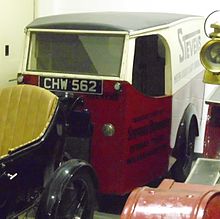Stevens Brothers
| Stevens Brothers (Wolverhampton) | |
|---|---|
| legal form | Ltd. |
| founding | 1932 |
| resolution | 1992 |
| Seat | Wolverhampton , England |
| Number of employees | 30-40 |
| Branch | Motorcycles , commercial vehicles , mechanical engineering |
The Stevens Brothers (Wolverhampton) Ltd. was a British manufacturer of motorcycles, commercial vehicles and machine parts, based in Wolverhampton (Staffordshire) from 1932 to 1992 .
history
Harry, George, Joe, Jack and Billie Stevens had previously run AJS on Graisley Hill in Wolverhampton. In October 1931 this company ran into economic difficulties and was taken over by competitor Matchless . The previous owners left the company and founded the Stevens Brothers (Wolverhampten) Ltd. in May 1932 . on Retreat Street, where the Stevens Screw Company Ltd., operated by father Joseph Stevens , was previously . was resident.
In 1934 Joe and Jack left the new company and started a new company, Wolverhampton Auto-Machinists Ltd. , who manufactured clamping devices for mechanical engineering. In the late 1930s, Harry took over Stevens Screw Company Ltd. from father. In 1938 Billie's son Jim Stevens joined the Stevens Brothers (Wolverhampton) Ltd. a.
During the Second World War , Stevens Brothers manufactured machine parts for the British aviation industry. In the 1940s, the Stevens brothers gradually died and in the 1950s, Jim Stevens sold the company to Leo Davenport , a businessman and former motorcycle racer. Jim then devoted himself to the continuation of the screw factory founded by his grandfather.
The manufacture of machine parts continued until 1992. Then operations ceased and the buildings were transferred to Engines Ltd. and W. Hopcraft & Son Ltd. sold.
Products
commercial vehicles
In 1932, Stevens Brothers took over the design of a motorcycle-based three-wheel delivery van from AJS that they had built in 1921. The front wheel sat in a motorcycle fork, but was steered with a steering wheel. The driver sat on a bench, later on a motorcycle saddle. The driver's seat and loading area were covered; the body was bought.
The van was powered by a water-cooled, side-controlled single - cylinder engine with 588 cm³ displacement, which Stevens Brothers manufactured itself. The engine power was transmitted to the rear wheels via a Burman three-speed gearbox with reverse gear and a chain. The engine was started with a kick starter in the cab. The throttle was mounted in the steering wheel.
The car weighed 394 kg and had a payload of 250 kg. It reached a top speed of 72 km / h and cost £ 83.
In 1935 the unreliable chain was replaced by a cardan shaft. The payload increased to 400 kg and the price to £ 93 9s. There was also an open pickup truck.
Six delivery vans were always built by hand at the same time. Only when these were sold was there space and money to manufacture six more. By the end of 1936, around 500 copies were made in this way, then production was discontinued due to insufficient demand.
motorcycles
In 1934, after Joe and Jack left the company, the remaining three brothers started building motorcycles again. First two models were launched, the DS1 and the US2 . Both were equipped with single-cylinder four-stroke engines with a displacement of 250 cm³, multi-plate oil bath clutches and Burman four-speed transmissions. The construction essentially corresponded to that of the earlier AJS models; the engines had magneto ignition and had a 6-volt lighting system. The letters Stevens were emblazoned on the saddle tanks of the machines, which were traditionally black .
Both models cost £ 51 and were handcrafted in lots of twelve in a rented factory nearby. Here, too, the next lot could only be started when the previous twelve machines had been sold.
Well-known motorcycle magazines tested the motorcycles and found them to be excellent.
In 1935 there were small improvements for both models and two new types with 350 cm³ displacement were added. The HL3 was how the DS1, a raised exhaust for off-road use, while the LL4 got the normal exhaust the US2. £ 52 was the price for both new models.
In April of the same year, a 500 cm³ machine was added as a fifth model, which had a reinforced and extended frame and was designed for sidecar operation. It cost £ 63 standard and £ 69 competition version which had a different gear ratio and different fenders. The fishtail exhaust was exchanged for a "megaphone model" as early as autumn.
The annual production was around 200 motorcycles and Stevens Brothers entered the head tester Tommy Deadman in various competitions, in which he achieved good results.
In 1937 the smaller models were also equipped with megaphone exhausts. This was the last change before motorcycle production ceased in the summer of 1938. The last two of the 1,000 or so Stevens motorcycles went to Joe's son Alec and Billie's son Jim .
Engines and machine parts
After motorcycle production was discontinued, only engine construction was continued. Harry Stevens designed a 1000 cc single-cylinder engine with an attached four-speed gearbox for George Brough , from it remained with a prototype. In addition, contract work was carried out for other metal construction companies.
During the Second World War, the company manufactured machine parts for aircraft engine manufacturers such as Bristol , Fairey Aviation , Avro , Handley Page and others. Stevens Brothers made a name for themselves as a manufacturer of difficult-to-manufacture machine parts.
The manufacture of machine parts continued until the company was dissolved in 1992.
